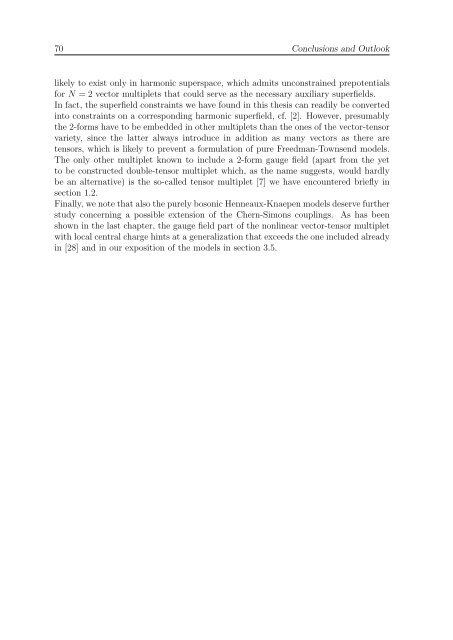N=2 Supersymmetric Gauge Theories with Nonpolynomial Interactions
N=2 Supersymmetric Gauge Theories with Nonpolynomial Interactions
N=2 Supersymmetric Gauge Theories with Nonpolynomial Interactions
You also want an ePaper? Increase the reach of your titles
YUMPU automatically turns print PDFs into web optimized ePapers that Google loves.
70 Conclusions and Outlook<br />
likely to exist only in harmonic superspace, which admits unconstrained prepotentials<br />
for N = 2 vector multiplets that could serve as the necessary auxiliary superfields.<br />
In fact, the superfield constraints we have found in this thesis can readily be converted<br />
into constraints on a corresponding harmonic superfield, cf. [2]. However, presumably<br />
the 2-forms have to be embedded in other multiplets than the ones of the vector-tensor<br />
variety, since the latter always introduce in addition as many vectors as there are<br />
tensors, which is likely to prevent a formulation of pure Freedman-Townsend models.<br />
The only other multiplet known to include a 2-form gauge field (apart from the yet<br />
to be constructed double-tensor multiplet which, as the name suggests, would hardly<br />
be an alternative) is the so-called tensor multiplet [7] we have encountered briefly in<br />
section 1.2.<br />
Finally, we note that also the purely bosonic Henneaux-Knaepen models deserve further<br />
study concerning a possible extension of the Chern-Simons couplings. As has been<br />
shown in the last chapter, the gauge field part of the nonlinear vector-tensor multiplet<br />
<strong>with</strong> local central charge hints at a generalization that exceeds the one included already<br />
in [28] and in our exposition of the models in section 3.5.

















